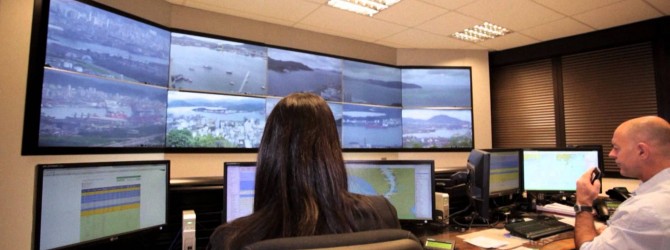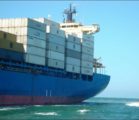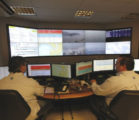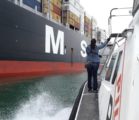
Pilotage Facilities Upgraded at Port of Santos
With the establishment of the Center for Coordination, Communication and Traffic Operations (C3OT), Santos PilotageServices in Brazil has solidified its position as one of the most modern and advanced pilotage service providers in the world. Video cameras strategically positioned along the Port, cutting-edge meteorological and oceanographic equipment designed to measure wave height, wave period, direction and speed of local currents and winds, tidal range and visibility, will allow a real-time and thorough monitoring of the Port of Santos channel throughout its 20 kilometers and 67 terminals and berths. The aim: to ensure greater agility and safety in the maneuvers of the ever growing-size ships that call at this port, and which require extra caution when navigating the narrow and winding stretches of the Santos channel.
Although such a system is already present in other modern ports around the world, the port authority is the one responsible for its implementation and maintenance. Pilotage companies are in charge of the service in some cases, but Santos Pilotage Services will be the first to own the equipment, which is considered the most advanced in the world.
So far, monitoring has only been done by AIS (Automatic Identification System), a transceiver that broadcasts information about the ship and its position (size, position, heading, speed, final destination and type of cargo). The new operations center will continue to make use of the AIS, but now integrate it with the video system and meteorological data.
In order to improve the safety in a channel where ferries, yachts, fishing boats, passenger boats and an increased number of large ships share the traffic, twelve video cameras have been positioned to cover the entire channel and terminals. With all this equipment, it will now be possible to monitor ships throughout their passage, relying on resources such as image zoom for detailed analysis of each maneuver.
The C3OT receives real-time broadcast images and displays them on a video wall with ten 46-inch LCD screens. In case any emergency occurs, the pilot will be warned via radio right away. A stronger wave or a storm surge, for instance, could affect the sea conditions, and this new equipment will show the exact situation in real time. Tidal heights will also be monitored in real time from five stations positioned along the channel.
The new equipment also features a visual range monitor, which will help prevent low-visibility situations due to sudden fog formation that could affect navigation safety.
All pilot boats are equipped with AIS, and one boat will be in charge of the constant monitoring of the area, informing the C3OT via radio of any abnormal events such as ships moored with slack mooring lines, evidence of oil spills or the presence of obstacles in the berthing area.
New Station
The operations room on the third floor of the Santos Pilot Station building enjoys a wide view of the channel and has all of the following at its disposal: a video wall, three consoles totally equipped with communication and data input systems, a system that is capable to integrate all the other systems and a situation or crisis room. The operations are carried out in a highly functional and hermetic environment, with a wide view of the channel and an access control system.
Crisis Room
The crisis room is located behind the C3OT consoles, separated by a transparent glass wall where the briefing with thepilot shall take place and where the managers and directors, who are in charge of following-up a possible crisis, shall meet up. Everyone will then benefit from all the visual aid coming from the video wall and will receive all the information needed for decision-making.
Crisis management is the activity that is carried out when a certain navigation event or accident exceeds the scope of competence of the regular operational regimen of the operations room, or when the issue to be dealt with should have greater implications for the community. When this happens, a board of managers and directors will meet up to help the operations room team make decisions, as well as to support the deployment of special resources usually needed during extraordinary events. Local maritime and port authorities shall be invited to follow the activities ‘in loco” in the crisis room.
Precise Guidelines
While an operator is in contact with CODESP (State of São Paulo Dock Co.) to receive all data concerning the maneuvers to take place along the day, another operator is collecting data and images of the sea conditions, which were previously obtained by the pilot boat patrolling the channel. With all this information, they can start planning the maneuvers, observing the ships’ restrictions, authorizations for docking/undocking and all draft and tide conditions.
Once the maneuver is authorized, the pilot comes to the C3OT and visualizes all necessary data on the IPad or on the service schedule screens and checks the operational conditions. At the top of the video wall, they can check information about the maneuvering conditions established by the local representative of the maritime authority, as well as information about the ship traffic along the channel.
The patrolling boat records a number of different events or situations that could affect the safety or punctuality of the maneuvers or cause seawater pollution. All data are then sent to the operational manager, who takes the necessary measures, alerting the local authorities in good time.
Pilotage Beyond Maneuverings
Responsible for maneuvering ships in the ports of Santos and São Sebastião, the contribution of State of São PauloPilotage Services has been paramount for the record exportation figures in both ports. Officially, pilots must keep only one operations center (pilot station) and boats for their transport from the station to the ships. In practice, however, pilots have invested high amounts to ensure greater agility in the job of traffic coordination.
Currently, 51 pilots work in the Port of Santos. Ten apprentices are going through their qualification stage, during which 600 maneuvers are required before they are awarded with their permanent licenses. All of them had been selected through a selection process undertaken by the maritime authority which is also responsible for fixing the number of pilots in each Brazilian Port.
State of São Paulo Pilotage Services performs over 12,000 maneuvers per year, and its infrastructure counts on the modern C3OT, equipped with the most advanced technology available presently. One hundred employees, a shipyard and 18 boats support all the activities. The service is available 24 hours a day, 365 days a year. The organization keeps this entire infrastructure in order to meet a hypothetical peak situation of 120 maneuvers per day, which would guarantee that no ship, under any circumstance, would ever be left unassisted due to a shortage of pilots. The annual average number or maneuvers is 32 per day.
Almost 100% Satisfaction
State of São Paulo Pilotage Services surveyed ship captains and onshore organizations and confirmed the expressive approval of the services provided by its pilots: 97.04 percent. An equally high rate was also recorded regarding agility and efficiency: 95.20 percent understand that their needs are well matched.
Carried out annually, the survey has two aims: to get to know how our clients evaluate our services so that occasional faults can be fixed, and to evidence the assessment, which is a requirement to keep the ISO 9001:2008 accreditation. In 1998, Santos Pilots was the first pilotage service provider in the American continent to be certified by the quality of its services.
More Cargo, Fewer and Bigger Ships
Up to year 2000, most ships that had been operating in the Port of Santos had a tonnage between 10,000 and 20,000. Their size, 160 meters in length and 25 meters in beam, was considered large then. Thirteen years later, this picture changed dramatically; in 2013, the number of maneuvers with ships of more than 50 thousand tons skyrocketed, reaching 2,900.
The size of the ships practically doubled, reaching lengths of up to 336 meters. It was as if one FIFA standard football pitch had been added to the old vessels. The navigation channel did not follow such growth, remaining practically the same and even narrower in some stretches.
Larger ships in the same narrow channel force the pilot to work under a high-risk situation, which requires the highest level of expertise in order to ensure that the traffic flows with safety and agility.
Results: in 13 years, it was recorded an increase of 331 percent in the number of containers and 165 percent in the general cargo handling , in spite of the number of ship calls having gone up by only 62 percent during such period.
The variation observed in the past five years is even more significant. From 2009 to 2013, there was an increase of 50 percent in the number of containers, an increase of 37 percent in tonnage and a decrease of 10 percent in the number of ships.
The inauguration of the new Center for Coordination, Communication and Traffic Operation of State of São Paulo Pilotage Services reinforces the historical effort that the organization has made to overcome the hurdles that could come to jeopardize the traffic flow in the nation’s largest and most important port.
| YEAR | CONTAINERS (thousands TEU) | TONS | CALLS (number of ships) |
| 2000 | 801 | 43.084.383 | 3.249 |
| 2001 | 1.048 | 48.161.593 | 3.669 |
| 2002 | 1.224 | 53.474.268 | 4.002 |
| 2003 | 1.385 | 60.077.073 | 4.161 |
Fonte: Maritime Executive



